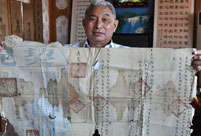

WELLINGTON, Jan. 12-- New Zealand researchers said on Monday they are closer to understanding the demise of the Polynesian people who carved the mysterious Easter Island statues before the arrival of Europeans.
The research on the demise of society on Easter Island also known as Rapa Nui suggested environmental constraints before European contact helped bring about the end of communities on the 163-square-km island, University of Auckland researchers.
Co-author of the study Professor Thegn Ladefoged said researchers analyzed more than 400 obsidian artifacts from six sites around the island, but focused primarily on three sites where they had good information on soil chemistry and climatic conditions in order to determine a timeline.
By determining when the artifacts were made, the scientists were then able to estimate land use and population increases and declines based on the number of tools made during each period.
The first site, on the northwest coast, showed an increase in population between 1220 and 1650 and then a rapid decline, but the site was also prone to drought as it was in the rain shadow of Terevaka volcano.
The second site in the interior of the island was less prone to drought, but had low soil fertility and showed an increase in use from 1200 to 1480 with steady use until 1705, before beginning to decline.
Both these sites showed declining population before the first European contact in 1722.
The third site, both rainy and fertile, showed an increase in use starting about 1250 and then fairly constant use until 1850.
"It is clear that people were reacting to regional environmental variation on the island before they were devastated by the introduction of European diseases and other historic processes," Ladefoged said in a statement.
The researchers hoped to examine individual dwellings to understand the interaction between Easter Islands aboriginal people and their environment.
Easter Island is thought to have been colonized around the 13th Century, but the culture and lifestyles of the Rapa Nui people have been mostly lost over centuries of turmoil, disease and European colonization.
 PLA soldiers operating vehicle-mounted guns in drill
PLA soldiers operating vehicle-mounted guns in drill Beauties dancing on the rings
Beauties dancing on the rings Blind carpenter in E China's Jiangxi
Blind carpenter in E China's Jiangxi Top 10 highest-paid sports teams in the world
Top 10 highest-paid sports teams in the world In photos: China's WZ-10 armed helicopters
In photos: China's WZ-10 armed helicopters UFO spotted in several places in China
UFO spotted in several places in China Certificates of land title of Qing Dynasty and Republic of China
Certificates of land title of Qing Dynasty and Republic of China  Cute young Taoist priest in Beijing
Cute young Taoist priest in Beijing New film brings Doraemon's life story to China in 3D
New film brings Doraemon's life story to China in 3D China-S.Korea FTA sets positive precedent
China-S.Korea FTA sets positive precedent Ferry carrying 458 people sinks in Yangtze River
Ferry carrying 458 people sinks in Yangtze River Mecca of Marxism
Mecca of Marxism Bring them home
Bring them homeDay|Week